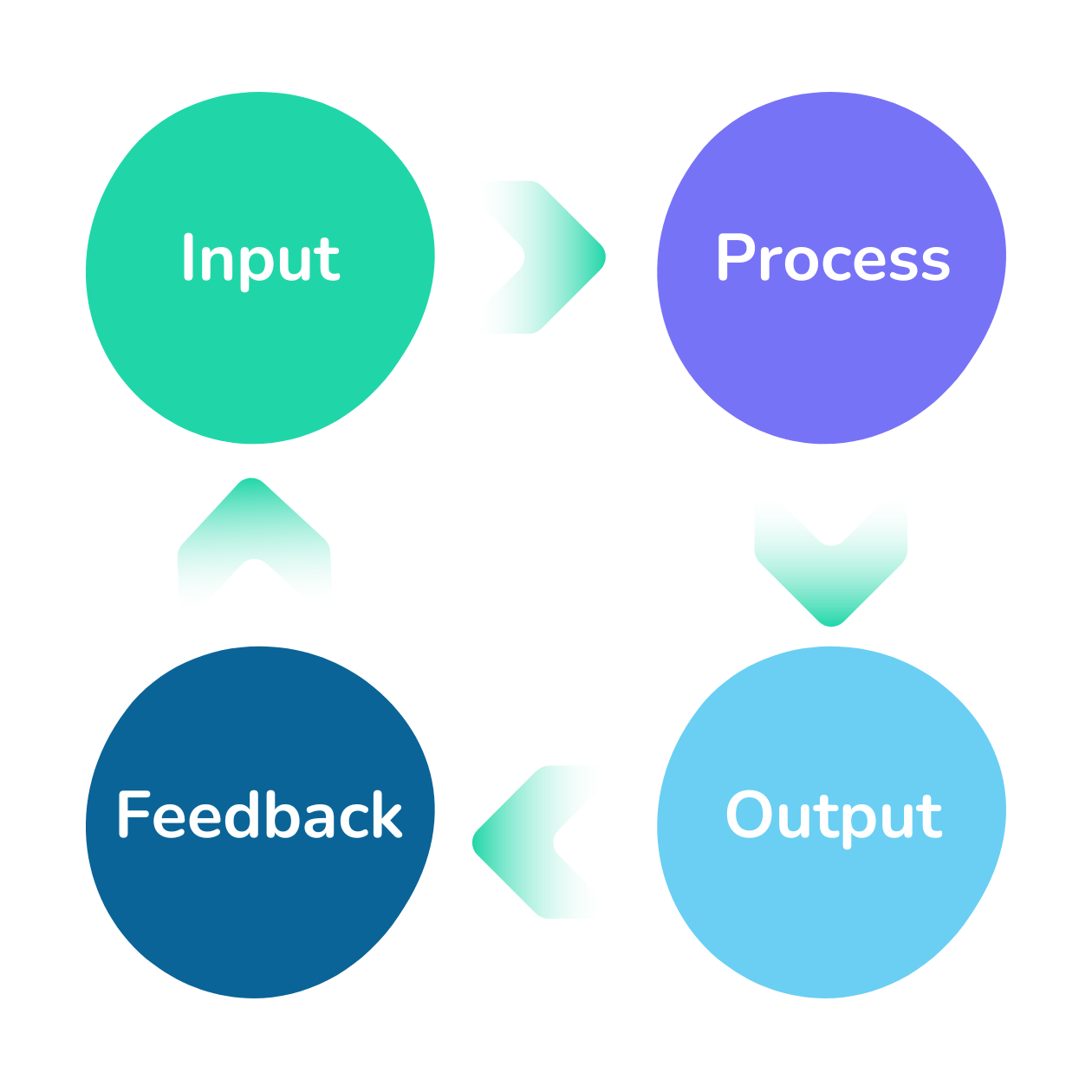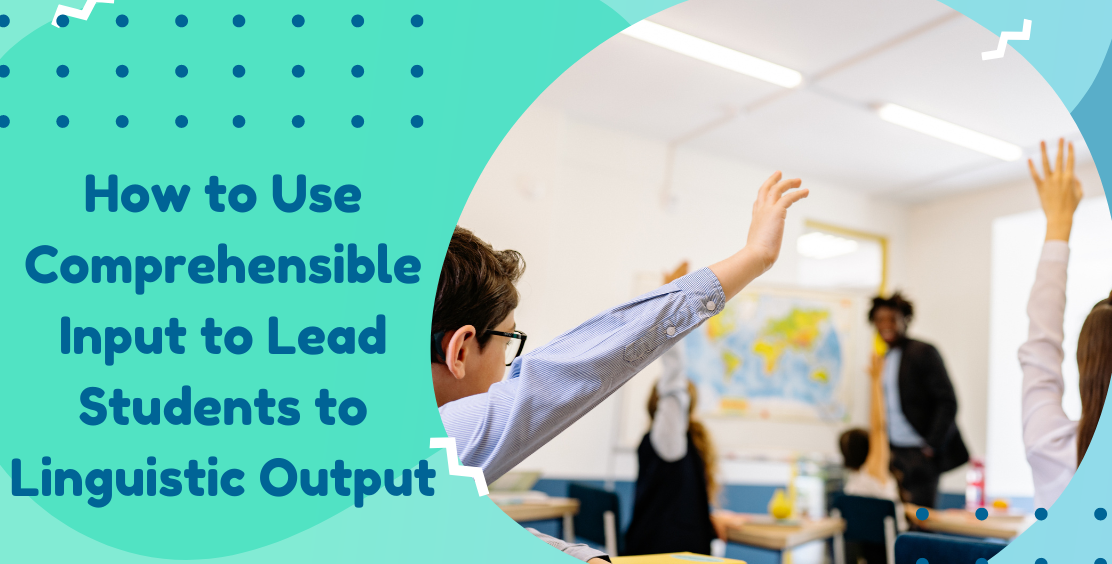
In this post, learn five strategies for teaching comprehensible input that guides students towards confident language output.
When language instructors discuss input and output, the result is usually a melting pot of ideas and theories. While no two classes are the same, language teachers agree that fundamentally, students need comprehensible input first in order to produce output. But how do we get from one to the other? How can we use comprehensible input to gradually encourage confident production of the target language?
To answer these questions, let’s unpack our terms.
Comprehensible Input
Input is everything we are exposed to in the target language–everything we read, hear, or watch. Linguist Stephen Krashen took this a step further and coined comprehensible input–a term to describe input that is simple, understandable, and supported by context. Successful comprehensible input uses information we already know to teach new words and concepts.
Putting comprehensible input into practice, we arrive at Krashen’s input hypothesis, which suggests that input should slightly challenge us, while still being comprehensible. In other words, we need to start with what we currently know, then receive more advanced input that propels learning forward.
Researchers have found significant benefits to input-based language instruction. For instance, one case looking at an EFL student’s language learning journey found that compelling, comprehensible input yielded greater gains than immersion. Moreover, this report shows rapid proficiency growth among several language students when they began to participate in comprehensible input, particularly in the form of self-selected reading (more on that later).
Output
Output is what we produce in the target language through speaking or writing. In the classroom, output may take the form of one-word identifications, small group conversations, student reports, or essays: anything that results in productive skills in the target language.
Linguist Merril Swain proposed the output hypothesis, which centers around the idea that the more we practice speaking and writing in the target language, the closer we get to language acquisition. More specifically, it helps us achieve fluency from a syntactic perspective.
Swain thought that as we practice language output, we acquire new skills through trial and error. By speaking to someone in the target language, we learn from their positive or negative feedback and adjust the output accordingly. If the recipient doesn’t understand our message, we’ll recognize the output was incorrect, and can try something else. If our message was understood, we’ll recognize its success and retain that output for future use. This feedback-oriented output prompts us to experiment with language and tap into our reservoir of vocabulary, which aids in retention and proficiency.
While output is a time for feedback, it’s also an opportunity to encourage confidence. When possible, instructors should avoid correcting grammar unless it significantly impacts the meaning of the student’s message, as this can be discouraging and further add to students' affective filters. Instead, output should facilitate meaning-based feedback where students can adjust their output according to the recipient’s response.
While output is a time for feedback, it’s also an opportunity to encourage confidence.
5 Tips for Teaching Comprehensible Input
It’s important to use comprehensible input as a foundation for students' formative learning periods, where they build up their language library and retain the knowledge required to produce output later on. Here are five ways to use comprehensible input as a springboard for language development.
Storytelling
Sparking interest through storytelling is one of the most impactful ways to engage students in comprehensible input. Relevant, understandable stories will push students to decipher new concepts for the sake of understanding the plot. Remember to appeal to their curiosity: if you as a teacher are telling the story, start with a “hook,” and use gestures or props to support. You can assess their comprehension of the story by asking questions about a particular character or theme, or by asking them to retell the story in their own words (it's helpful to do this in their shared language too, not the target language). This is also an opportunity for partner work, where students go back and forth retelling plot points in their correct order.
It’s important to use comprehensible input as a formative and engaging period, where students build up their language library and retain the knowledge required to produce output later on.
Visual Support
Images and graphics are your new best friend. Anytime you can include visual representation of a new concept, the more likely students are to understand and remember. Try to think outside the box too–you can use digital visual aids like GIFs, videos, or comics to enhance learning. For an interactive activity, play a short movie clip related to your lesson (for beginners, choose a clip that has more action than dialogue). Pause to describe the scene and identify objects in the target language. While the main focus of this activity is to provide comprehensible input, you can choose to add output practice by asking students to call out objects of the scene in the target language.
Listening Exercises
Students need ample listening opportunities when absorbing comprehensible input. Since listening can be more challenging than reading (given the variables of speed, duration, pronunciation, etc.), providing listening exercises that are simple and clear yet sufficiently challenging will ensure students are well-prepared to produce output. Check out our recommendations for best listening exercises here.
Self-Selected Reading
As much as we’d like to deny it, many students avoid academic reading, particularly if the content isn’t relatable or interesting to them. For this reason, it’s important to provide self-selected reading opportunities, where students can choose the topic they read about. Encourage fictional content, as this is most likely to appeal to students’ interest and keep them engaged with the text. Research shows there is a strong connection between interest and reading comprehension, and that self-selected reading (also called 'free voluntary reading' - FVR) resulted in substantial vocabulary gains and higher TOEIC scores.
The results of several kinds of studies suggest that self-selected reading of fiction does indeed develop the habits of thought needed for school and career success. - Krashen
Essentially, the more interested students are in the text, the more likely they will comprehend and remember. Assessments for self-selected reading could be an essay, reflection or verbal response highlighting the chosen text. Looking for specific reading assessment ideas? Check out some of our favorites here, or watch the video below.
Customized Assessments
Extempore allows language instructors like yourself to customize assessments for the specific focus of your class. How well are your students comprehending input? What are their output abilities? To start, create assessments that don’t require any original output, but that simply measure students' level of understanding. Ideally, these questions and answers should be written in the shared language rather than the target language, so as to avoid students parroting back the target language without knowing what it actually means. As students progress and produce more output, you can customize your assessments to include more written and audible responses in the target language.

Encourage Confident Output
With comprehensible input in their toolbelts, students should feel well-equipped to attempt speaking and writing in the target language. Practicing output should be a time for trial and error, where students use positive and negative feedback to identify their language proficiency and sort through their existing knowledge. Encourage small group work during this period, where students can practice output among peers in a low-stakes environment.
As a language instructor, you know what your students need to excel. Finding the right combination of input and output can vary based on grade level, proficiency, and student performance. A general rule of thumb is that beginners benefit from more comprehensible input, and that output can increase as proficiency does. Still, the need for comprehensible input remains at any level, as there is always more to absorb–that’s what we love about language learning!
Works Cited
Bland, J., Krashen, S. (2014). Compelling Comprehensible Input, Academic Language and School Libraries. CLELE Journal, 2 (2).
Fahrurrozi (2017). Relationship Between Students’ Reading Interest and Vocabulary Mastery with Reading Comprehension Ability. Atlantis Press, 118 (59), 357-363. https://doi.org/10.2991/icset-17.2017.59
Mason, B., Krashen, S. (2019). Hypothesis: A Class Supplying Rich Comprehensible Input is More Effective and Efficient than “Immersion.”
Mason, B., Krashen, S. (2018). Self-Selected Reading and TOEIC Performance: Evidence from Case Histories.
This is a guest post written by Maggie Twaroski.



